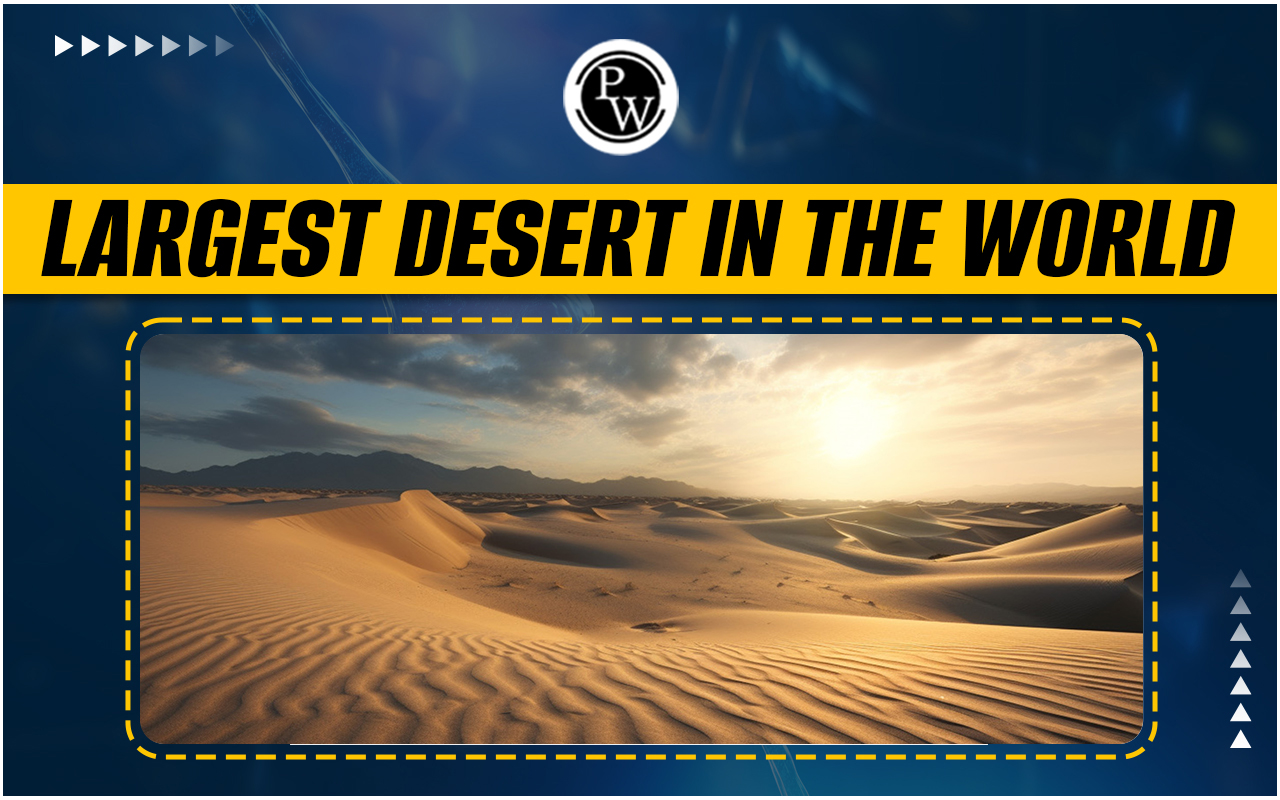

Largest Desert in the World
A desert is a distinct geographical region characterised primarily by its extreme aridity and minimal precipitation levels. These regions are characterised by their harsh, dry climates, which result in a scarcity of moisture and, consequently, limited vegetation and water sources. Deserts can be found on every continent across the globe. Collectively, these desert regions cover approximately one-third of the Earth's total land surface. Deserts are unique and diverse geographical regions defined by their arid, dry climates, minimal precipitation, sparse vegetation, and limited water sources. They are found on every continent and cover a significant portion of the Earth's land surface, presenting an array of challenges and adaptations for both the natural world and human inhabitants. The Largest Desert in the World can be found in an unlikely place, Antarctica. This expansive desert, primarily composed of polar ice and tundra, spans a vast area of approximately 14,200,000 sq. kilometres.Types of Deserts
Deserts come in several different types, each with its own unique characteristics. The main Types of Deserts are:Hot and Dry Deserts:
Climate: Hot and dry deserts, also known as subtropical deserts, are characterized by extremely high daytime temperatures and cooler nights. These regions typically receive minimal precipitation, often less than 250 millimeters (10 inches) annually. Examples: Hot and dry deserts can be found on various continents, with the Sahara Desert in Africa, the Sonoran Desert in North America, and the Arabian Desert in the Middle East serving as prime examples.Cold Deserts:
Climate: Cold deserts, also referred to as temperate deserts, experience cold winters and may even receive snowfall. Typically located at higher latitudes or elevations, they have relatively warm summers but lack the extreme heat of hot deserts. Examples: The Gobi Desert in Asia and the Great Basin Desert in North America are prime examples of cold deserts.Coastal Deserts:
Climate: Coastal deserts are situated along coastlines and are influenced by cold ocean currents. These regions generally experience mild temperatures and low rainfall, with fog often serving as a significant source of moisture in some coastal deserts. Examples: Notable coastal deserts include the Namib Desert in Africa and the Atacama Desert in Chile.Semi-Arid Deserts:
Climate: Semi-arid deserts occupy a climate zone that falls between true deserts and more temperate regions. They receive more precipitation compared to hot deserts but still endure prolonged dry spells and occasional droughts. Examples: Regions like the Chihuahuan Desert in North America and certain areas of the Australian Outback can be categorized as semi-arid deserts.Top 10 Largest Desert in the World
The Top 10 Largest Desert in the World, based on their size and location, include:| Top 10 Largest Desert in the World | |||||
| S. No. | Name | Type | Location | Area (in sq.km) | Area (in sq.mi) |
| 1. | Antarctica Desert | Polar ice and Tundra | Antarctica | 14,200,000 | 5,482,651 |
| 2. | Arctic Desert | Polar ice and Tundra | Eastern Europe Northern America Northern Asia Northern Europe | 13,900,000 | 5,366,820 |
| 3. | Sahara Desert | Subtropical | Eastern Africa Middle Africa Northern Africa Western Africa | 9,200,000 | 3,552,140 |
| 4. | Great Australian | Subtropical | Australia | 2,700,000 | 1,042,476 |
| 5. | Arabian Desert | Subtropical | Western Asia | 2,330,000 | 899,618 |
| 6. | Gobi Desert | Cold winter | Eastern Asia | 1,295,000 | 500,002 |
| 7. | Kalahari Desert | Subtropical | Southern Africa | 900,000 | 347,492 |
| 8. | Patagonian Desert | Cold winter | South America | 673,000 | 259,847 |
| 9. | Syrian Desert | Subtropical | Western Asia | 500,000 | 193,051 |
| 10. | Great Basin | Cold winter | North America | 492,098 | 190,000 |
Major Largest Desert in the World
Major Largest Desert in the World are as follows:Antarctic Desert
The Antarctica Desert, Largest Desert in the World, spans an expansive 14,200,000 square kilometers in the region of Antarctica and its surrounding oceans.- This Largest Desert in the World is characterized by its extreme cold, featuring freezing temperatures and a thick blanket of ice.
- Remarkably, the Antarctica Desert harbors nearly 70% of the planet's freshwater reserves, stored in the form of ice.
- Despite its icy appearance, the Largest Desert in the World witnesses exceptionally low levels of precipitation.
- In terms of size, it outstrips even the renowned Sahara Desert in North Africa.
- The Antarctica Desert is officially categorized as a polar desert, primarily due to its harsh and frigid environmental conditions.
- Notably, this seemingly inhospitable desert is home to a diverse range of unique wildlife, including penguins, seals, and various seabird species.
Arctic Desert
The Arctic Desert, second Largest Desert in the World at 13,900,000 sq. km, resides in the polar region. It spans 2,000 km from east to west and 1,000 km from north to south, encompassing island groups north of Norway and Russia. With a harsh climate, scarce precipitation, and a unique ecosystem, this remote desert is a testament to the extreme conditions in our planet's polar zones, where life, including Arctic foxes, polar bears, and marine species, has adapted remarkably to survive.Sahara Desert
The Sahara Desert, situated in North Africa, ranks as the world's largest hot desert and the third Largest Desert in the World overall, enveloping a vast expanse of 9.1 million square kilometres (3.5 million square miles) characterised by arid and gusty terrain. This immense desert stretches across Northern Africa, extending from the Atlantic Ocean to the Mediterranean Sea and even reaching the Red Sea. In proximity to these bodies of water, the Sahara receives a modest annual rainfall of approximately 4 to 10 inches.Great Australian Desert
The Great Australian Desert, situated in Australia, spans approximately 2,700,000 square kilometres, ranking as the fourth Largest Desert in the World. It comprises roughly 18% of the Australian mainland's total land area. Australia holds the title of the driest continent on Earth, with approximately 35% of its landmass receiving such minimal precipitation that it almost qualifies as desert terrain. Precipitation in the Australian Desert is irregular and sporadic.Arabian Desert
Situated in the Middle East, the Arabian Desert stands as fifth Largest Desert in the World and one of the planet's most expansive deserts. Distinguished from the Syrian and North Arabian Deserts, it ranks as the world's second-largest subtropical desert, spanning an extensive area of 2.3 million square kilometres across the Arabian Peninsula. This desert region also serves as the habitat for 102 unique mammal species and hosts a diverse avian population, having 310 distinct bird species.Largest Desert in India
The Thar Desert, often referred to as the Great Indian Desert, holds the distinction of being India's largest desert. This vast expanse stretches across the northwestern region of India, reaching into neighboring Pakistan. The Thar Desert is renowned for its arid climate, marked by extensive stretches of sandy landscapes, scarce vegetation, and a notable scarcity of water sources. Despite these formidable challenges posed by its environment, the Thar Desert is home to diverse communities and sustains a unique ecosystem comprising of flora and fauna specially adapted to thrive in desert conditions.Features of Largest Desert in the World
Some of the characteristics of Desert are mentioned below for better understanding of Largest Desert in the World- Scarce Precipitation: Deserts are characterized by their minimal precipitation levels, often receiving less than 250 millimeters (10 inches) of rain annually. This scarcity of moisture is a defining attribute of desert landscapes.
- Extreme Temperature Extremes: Desert regions are renowned for their dramatic temperature fluctuations. They can endure scorching daytime heat and chilling cold nights due to the absence of cloud cover, which traps heat in other climates.
- Sparse Vegetation: The limited water supply in deserts restricts plant growth. Desert flora has evolved to conserve water, with many species exhibiting specialized adaptations such as succulence (the ability to store water in their tissues) and reduced leaf size to minimize water loss.
- Diverse Terrains: Deserts are incredibly diverse, with various types such as sandy deserts (e.g., Sahara Desert), rocky deserts (like the Mojave Desert), and salt flats (as seen in the Atacama Desert). Each desert type showcases a unique landscape and ecological adaptations.
- Unique Flora and Fauna: Despite the harsh conditions, deserts host a wide array of plant and animal species that have evolved to survive in this challenging environment. Some desert animals are nocturnal to escape the daytime heat, while others have evolved unique water-conservation mechanisms.
- Limited Surface Water: Natural water sources, such as rivers and lakes, are typically scarce and intermittent in desert regions. Oasis areas, where underground water rises to the surface, can sustain more substantial vegetation and even human settlements.
Importance of Largest Desert in the World
- Beyond the regional, territorial, and geographical importance of Largest Desert in the World, having a thorough grasp of the details is crucial, especially in the context of competitive exams.
- Static General Knowledge (GK) is a significant component of competitive exams, although its weightage may vary from one exam to another.
- Aspirants preparing for competitive exams should dedicate sufficient time to study Static GK as it frequently contributes a substantial number of questions.
| Other Related Links | |
| Tiger Reserves in India | National Parks in India |
| Biosphere Reserves in India | Elephant Reserves in India |
Largest Desert in the World FAQs
Q1. Which is the largest desert in the world?
Ans. The world's largest desert is the Antarctic Desert, an expansive region of polar ice and tundra situated in Antarctica. It encompasses a vast area of approximately 14,200,000 square kilometers.
Q2. Which type of climate does Antarctica Desert have?
Ans. The Antarctic desert experiences frigid weather conditions, with temperatures frequently falling far below the freezing point.
Q3. Which is the biggest and coldest desert in Asia?
Ans. Gobi Desert is the biggest and coldest desert in Asia
Q4. Which continent was known to have no desert?
Ans. Europe is the continent with no desert.
🔥 Trending Blogs
Talk to a counsellorHave doubts? Our support team will be happy to assist you!

Free Learning Resources
PW Books
Notes (Class 10-12)
PW Study Materials
Notes (Class 6-9)
Ncert Solutions
Govt Exams
Class 6th to 12th Online Courses
Govt Job Exams Courses
UPSC Coaching
Defence Exam Coaching
Gate Exam Coaching
Other Exams
Know about Physics Wallah
Physics Wallah is an Indian edtech platform that provides accessible & comprehensive learning experiences to students from Class 6th to postgraduate level. We also provide extensive NCERT solutions, sample paper, NEET, JEE Mains, BITSAT previous year papers & more such resources to students. Physics Wallah also caters to over 3.5 million registered students and over 78 lakh+ Youtube subscribers with 4.8 rating on its app.
We Stand Out because
We provide students with intensive courses with India’s qualified & experienced faculties & mentors. PW strives to make the learning experience comprehensive and accessible for students of all sections of society. We believe in empowering every single student who couldn't dream of a good career in engineering and medical field earlier.
Our Key Focus Areas
Physics Wallah's main focus is to make the learning experience as economical as possible for all students. With our affordable courses like Lakshya, Udaan and Arjuna and many others, we have been able to provide a platform for lakhs of aspirants. From providing Chemistry, Maths, Physics formula to giving e-books of eminent authors like RD Sharma, RS Aggarwal and Lakhmir Singh, PW focuses on every single student's need for preparation.
What Makes Us Different
Physics Wallah strives to develop a comprehensive pedagogical structure for students, where they get a state-of-the-art learning experience with study material and resources. Apart from catering students preparing for JEE Mains and NEET, PW also provides study material for each state board like Uttar Pradesh, Bihar, and others
Copyright © 2025 Physicswallah Limited All rights reserved.
Get App











